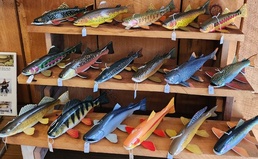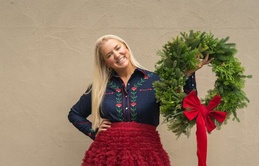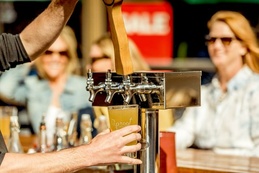Clothes horse
July 3, 2011
Equestrian fashion for Horse Shows by the BayBy Kristy Kurjan
From polo shirts to riding boots, equestrian fashion is not just for the stables anymore. The sport of horse riding is becoming more fashion conscious. While the English inspired garb is still very traditional, what has evolved in recent years is the selection, technology and availability of stylish riding gear.
We all admire the stately equestrian look, but what exactly goes into a well-dressed rider?
Equestrian Elements
There are a hand full of universal elements that create the “equestrian look” including; pants, boots, and fitted jacket. While in the saddle, a rider needs a good pair of breeches (pants), because if a rider’s pants don’t fit, they are not comfortable. Riding pants are slim in nature but not so tight that they limit a rider’s mobility on the horse.
“They need to be clean, well fitted, nothing flapping. Clothes that are very loose may get in the way, or get stuck in the stirrups,” said Jess Collins, owner of Red Hare Tack & Togs, an equestrian boutique located on Front Street in downtown Traverse City. “If you are competing in a horse show, clothes that are much too loose or way too tight will also be unsightly to the judge. Bottom line, you can really see a difference.”
From the Saddle to the Street
Real style takes shape in the barn, where the day-to-day equestrian lifestyle look is perfected. This is where trends like polo shirts, slim pants, and denim come to life. This preppy style is casual and easily makes the transition from the saddle to the streets. Rubber boots called “wellies” are ideal for cleaning and bathing a horse and come in all types of patterns and colors.
A few of the more popular equestrian brands include; Pikeur, Gersemi, Joules, Kerrits, Kingsland, Equine Couture and Goode Rider (all of which are available at Red Hare Tack & Togs.) These names are known for their bold colors and preppy silhouettes that signify the equestrian lifestyle.
One of the most coveted and universally admired horseback riding elements is a riding boot. While leather riding boots are marketed in stores, authentic equestrian custom-made boots are much more complex with study construction and solid heal. Collins explains, a rider would never wear “street riding boot” in the saddle, as with any sporting equipment, horse riding boots are made especially for the activity.
Most enthusiasts agree that a helmet is the most important piece to a rider’s wardrobe because ultimately safety is always in fashion. During competition, all riders under the age of 18 must wear protective headgear while on a horse.
Dressage & Hunter/Jumper
There is a very distinct difference between barn attire and a performance wardrobe; Barn styles are more casual while show styles are much more formal with strict traditional elements. Many of the traditional styles have not changed because there are governing rules to follow while competing. The two main areas are Dressage and Hunter/Jumper; each have a distinct set of wardrobe requirements that riders must adhere to during competition.
In terms of fashion, the dressage event is the most strict category at a horse show. It is occasionally referred to as a “horse ballet” because it involves performing to music, similar to a long-program in figure skating. Competitors are required to wear a traditional riding coat of conservative color with a tie choker or stock tie, white or light-colored breeches, and protective headgear. At the highest level, a dark tailcoat with top hap is worn. Depending on the competition, the top hat might be replaced with a helmet for safety reasons. Hair must not be showing and should be pulled back in a bun and loud colors are not allowed. Judges even look at the rider’s boots which can not have laces.
For a Hunter/Jumper competition the dress code is less strict, but traditional attire is still required. Riders still don dark coats, white shirts, breeches and protective head gear. Even during this part of the competition, Polo shirts and chaps are not permitted.
Expression Through Details
In a sport with such strict guidelines, hunter/jumper competitors often express their individuality through details. There are more color and fabric choices available including more breathable options and comfortable materials. Pattern fabrics in plaid, paisley and stripes help to bring individuality to an equestrian wardrobe.
“You’ll see them wear fun belts and choose linings on the inside of their riding coats that may be a pattern or color,” said Alexandra Rheinheimer, owner and director of Horse Shows by The Bay Equestrian Festival. “If someone has a pink underside to their jacket or some bling on their belt you can usually predict they are fun and tend to be a bit on the wild-side!”
Another way to show independence in the barn is through the horse. Riders choose different colored saddle pads and ribbons to make their horse look their best. “Back in the day we expressed ours by tying a special color of yarn into one of the braids in the mane,” said Marlene Dykhouse Wierenga, an avid rider and lover of horses. “Red, white and blue was a color of choice for the 4th of July shows or sometimes a color that matched our shirts.”
Fashionable Shows
If you want to see the very best in equestrian sport and fashions then Horse Shows by the Bay is the place to be during the month of July. The five week summer series of competitions takes place at Flintfields Horse Park in Williamsburg, just east of TC. Founded in 2004, it has since grown into one of the nation’s top horse and riding shows attracting thousands of people from across the country to Northern Michigan. The festival’s attendees are some of the most elite athletes that the sport has to offer.
“They represent the epitome of what to wear while riding and are always up on the latest trends,” explains Rheinheimer. This year, Horse Shows by the Bay was given a rating of “20” from the North American Riders Group that surveyed the best shows in North America. “In our short existence we’ve immediately excelled to being ranked among the best shows on the continent,” said Rheinheimer. “This is the first year our show jumping folks will be in town for four weeks which means more people than ever competing on our grounds and staying here in Traverse City.”
Spectators of the sport are fashionable too. Attendees at Horse Shows by the Bay they should wear comfortable clothing that’s conducive to the climate since we are outdoors and exposed to the elements. On a hot and sunny day don’t forget the sunscreen or a big hat and something that lets the air flow, like a sundress. For colder days, there’s nothing like a good pair of rubber wellies to keep dry.
Spectators Welcome
Intrigued by equine fashion and horseback riding competitions? Attend Horse Shows by the Bay to check it out for yourself throughout July.
The five week show series on the grounds in Williamsburg starts on Wednesdays and ends on Sundays. Featured events are scheduled on the weekends and include the exciting Grand Prix plus exhibitions, special family day activities, and charity fundraisers.
The 2011 Horse Shows by the Bay Equestrian Festival event dates:
Week 1 : June 30-July 2
Week 2: July 9-10
Week 3: July 16-17
Week 4: July 22-24
Week 5: July 30-31
Trending

The Art of the Decoy
On mantles and shelves around the country (and indeed, around the world) sit intricate and beautiful wooden fish decoys that… Read More >>
Wreath the Halls
Get ready for the holidays with the ultimate wreath workshop! Boyne Mountain hosts Wreathfest, Saturday, Nov. 8, with Kalin … Read More >>
TC Beer Week Is Back!
Traverse City will be getting sudsy this weekend, as Traverse City Beer Week returns Nov. 7-15. This year, each day has a th… Read More >>


